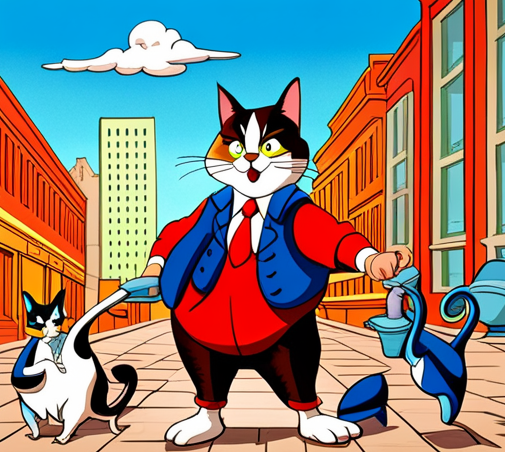For nearly a century, Looney Tunes has entertained audiences with its slapstick humor and iconic characters. Among these characters, a select few felines have carved a paw print in animation history, captivating viewers with their cunning, clumsiness, and undeniable charm. This definitive guide delves into the world of Looney Tunes cat names, exploring their origins, significance, and the personalities they represent.

Looney Tunes Female Cat Names: Sass and Sophistication
Looney Tunes boasts a limited roster of female felines, but each name is carefully chosen to reflect the character’s personality.
- Penelope Pussycat: Arguably the most recognizable female Looney Tunes cat, Penelope Pussycat is Pepé Le Pew’s constant object of affection. Her name evokes a sense of elegance and refinement, a stark contrast to Pepé’s persistent pursuit. “Penelope” is a timeless name with Greek origins, meaning “weaver” or “duck.” This name choice could be a subtle nod to Penelope’s ability to deftly evade Pepé’s advances. “Pussycat,” on the other hand, is a more playful term for a cat, adding a touch of whimsy to her character.
Looney Tunes Female Cat Names
| Character Name | Significance |
|---|---|
| Penelope Pussycat | Elegance, Refinement |
Beyond Penelope: While Penelope Pussycat reigns supreme, there are a few other mentions of female cats in Looney Tunes. In the short “Claws for Alarm!,” a nameless, seductive feline attempts to lure a lovesick bulldog away from his post. Her unnamed status allows viewers to project their own interpretation onto this mischievous character.
Looney Tunes Male Cat Names:Mischief and Mayhem
Male cats are a more prominent feature in Looney Tunes, and their names often reflect their comedic roles.
- Sylvester J. Cat: The perennial antagonist of Tweety Bird, Sylvester’s name embodies a sly and cunning personality. “Sylvester” is a Roman name meaning “forest dweller,” a fitting moniker for a cat constantly stalking his prey. The addition of the middle initial “J” adds a touch of formality, perhaps a sarcastic commentary on Sylvester’s often-bumbling attempts to catch Tweety.
- Babbit and Catstello: This duo, a parody of the comedy team Abbott and Costello, are a unique case. While the portly cat is never addressed by name, the taller, thinner cat is sometimes referred to as “Catstello.” This name choice is a humorous homage to the real-life comedic duo, further emphasizing the slapstick nature of their characters.
Looney Tunes Male Cat Names
| Character Name | Significance |
|---|---|
| Sylvester J. Cat | Sly, Cunning |
| Babbit (Unofficially Catstello) | Slapstick Duo |
Beyond Sylvester and Babbit: A few other male Looney Tunes cats deserve mention. In “The Hep Cats,” a group of alley cats serenade a female feline with jazzy music. These unnamed cats represent the cool cats of the era, adding a musical element to the feline lineup. Additionally, there’s Marc Antony, a sophisticated cat who appears in “Roman Legion Hare.” His name, referencing the famous Roman triumvir, adds a touch of historical grandeur to this sophisticated feline.
Interesting Trivia: Interestingly, the name “Tom Cat” is often mistakenly associated with Looney Tunes. However, this name belongs to the feline antagonist in the Tom and Jerry series.
Looney Tunes Black Cat Name: Superstitions and Spooks
Black cats have long been associated with bad luck and superstition. Looney Tunes uses this symbolism to create a memorable character.
- Black Cat (Inki): Appearing in the short “Inki and the Mystery of the Missing Boop-Boop,” this unnamed black cat, often referred to simply as “Inki” (meaning “inky” in Finnish), plays a detective role. The character’s black fur reinforces the association with mystery and the unknown, adding a spooky element to the story.
Beyond Inki: There are no other prominent black cats in Looney Tunes. However, the occasional background character or anonymous feline might sport a black coat, adding a touch of variety to the feline cast.
Looney Tunes Cat Characters Names: A Celebration of Legacy
Looney Tunes cat names are more than just monikers; they are an integral part of the characters’ identities.
- Sylvester J. Cat: “Sylvester” perfectly captures the character’s devious nature, while the middle initial adds a layer of (misplaced) sophistication.
- Babbit and Catstello: Their names directly reference the comedic duo they parody, cementing their slapstick roles.
- Penelope Pussycat: This name embodies elegance and grace, a stark contrast to a stark contrast to Pepé Le Pew’s relentless pursuit.
Evolution of Cat Names: While Looney Tunes cat names haven’t undergone drastic changes, there are some interesting observations. Earlier cartoons often used more generic terms like “cat” or “pussycat.” As characters like Sylvester and Penelope developed distinct personalities, their names became more specific and tied to their comedic purpose.
The Allure of Alliteration: Looney Tunes has a fondness for alliteration, a literary device where words begin with the same consonant sound. This technique is evident in names like Sylvester J. Cat and Marc Antony, adding a catchy quality to the characters’ monikers.
Cats Names from Looney Tunes: A Global Appeal
Looney Tunes has reached audiences worldwide, and the translation of cat names offers a fascinating glimpse into different cultural interpretations.
- Sylvester J. Cat: In French translations, Sylvester becomes “Grosminet” or “Titi,” names that don’t directly translate but still evoke a mischievous personality.
- Penelope Pussycat: Penelope’s name often remains unchanged, although some translations might use local terms for “cat” instead of “pussycat.”
The Importance of Context: Understanding the context in which a cat name appears is crucial. For instance, in the short “Claws for Alarm!,” the unnamed, seductive feline’s lack of a name allows viewers to project their own interpretations onto her character, adding a layer of mystery.
Looney Tunes: A Street Cat Named Sylvester
Beyond individual names, Looney Tunes occasionally uses titles to introduce feline characters. A prime example is the 1941 short “A Street Cat Named Sylvester,” which formally introduces Sylvester J. Cat to the Looney Tunes universe. The title itself sets the stage for Sylvester’s cunning and streetwise persona, establishing him as a determined alley cat on the prowl.
Conclusion
Looney Tunes cat names, though seemingly simple, are meticulously chosen. They reflect the characters’ personalities, comedic roles, and even historical references. From the cunning Sylvester J. Cat to the elegant Penelope Pussycat, these feline monikers have become synonymous with laughter and animation history. Understanding the stories behind these names allows for a deeper appreciation of the characters themselves and the enduring legacy of Looney Tunes.
FAQs
- What is the most famous Looney Tunes cat name? Sylvester J. Cat is arguably the most recognizable Looney Tunes feline.
- Is Tom Cat a Looney Tunes character? No, Tom Cat is the antagonist in the Tom and Jerry series.
- Why are there so few female Looney Tunes cats? Looney Tunes historically focused on male characters. However, Penelope Pussycat stands out as a memorable female feline.
- What is the significance of black cats in Looney Tunes? The black cat character “Inki” plays on the superstition associated with black cats, adding a spooky element to the story.
You might also want to check out these articles for more ideas: Serengeti Cat Names






